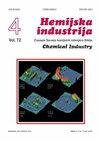利用功能化氧化铝颗粒改善复合膜的抗空化性能
IF 0.8
4区 工程技术
Q4 ENGINEERING, CHEMICAL
引用次数: 8
摘要
以UV固化的双- gma(双酚A -甲基丙烯酸酯)/TEGDMA(三乙二醇二甲基丙烯酸酯)为基体,以氧化亚铁掺杂氧化铝(Al2O3 Fe)为基颗粒,制备了复合薄膜并进行了空化处理。为了提高复合材料的力学性能和粘附性能,对填充颗粒进行了4种不同的表面改性:3-甲基丙烯氧基丙基三甲氧基硅烷(MEMO)、乙烯基三(2-甲氧基乙氧基)硅烷(VTMOEO)、(3-氨基丙基)三甲氧基硅烷(APTMS)和生物柴油(BD)。复合薄膜分别由0.5、1.5和3wt %的氧化亚铁掺杂氧化铝颗粒和上述每一种表面改性制成。在黄铜基底上制备复合薄膜,并进行空化腐蚀。利用质量损失监测腐蚀过程,利用图像分析观察表面缺陷。以VTMOEO为表面改性剂的Al2O3 Fe增强复合膜在质量损失和表面破坏程度方面是最耐的。结果表明,采用表面改性填料制备的复合材料在抗空化性能上均有一定的提高。本文章由计算机程序翻译,如有差异,请以英文原文为准。
Improvement of cavitation resistance of composite films using functionalized alumina particles
Composite films having the UV cured Bis-GMA (Bisphenol A glycidylmethacrylate)/TEGDMA (triethylene glycol dimethacrylate) as a matrix and the ferrous oxide doped alumina (Al2O3 Fe) based particles were prepared and subjected to cavitation. In order to improve the mechanical and adhesion properties of composites, four different surface modifications of filler particles were performed: 3-methacryloxypropyltrimethoxysilane (MEMO), vinyltris(2-methoxyethoxy)silane (VTMOEO), (3-aminopropyl)trimethoxysilane (APTMS) and biodiesel (BD). Composite films were made with 0.5, 1.5, and 3 wt.% of ferrous oxide doped alumina particles with each of the mentioned surface modifications. Composite films were prepared on brass substrates and exposed to cavitation erosion. The erosion was monitored using the mass loss while image analysis was used to observe surface defects. The composite film reinforced with Al2O3 Fe having VTMOEO as a surface modifier was the most resistant one in terms of mass loss, as well as the level of surface destruction. Results were compared to the same polymer matrix film and composite films prepared with fillers without surface modifications revealing that all composites with surface modified fillers exhibited some improvement in resistance to cavitation.
求助全文
通过发布文献求助,成功后即可免费获取论文全文。
去求助
来源期刊

Hemijska Industrija
工程技术-工程:化工
CiteScore
1.60
自引率
11.10%
发文量
12
审稿时长
6-12 weeks
期刊介绍:
The Journal Hemijska industrija (abbreviation Hem. Ind.) is publishing papers in the field of Chemical Engineering (Transport phenomena; Process Modeling, Simulation and Optimization; Thermodynamics; Separation Processes; Reactor Engineering; Electrochemical Engineering; Petrochemical Engineering), Biochemical Engineering (Bioreactors; Protein Engineering; Kinetics of Bioprocesses), Engineering of Materials (Polymers; Metal materials; Non-metal materials; Biomaterials), Environmental Engineeringand Applied Chemistry. The journal is published bimonthly by the Association of Chemical Engineers of Serbia (a member of EFCE - European Federation of Chemical Engineering). In addition to professional articles of importance to industry, scientific research papers are published, not only from our country but from all over the world. It also contains topics such as business news, science and technology news, information on new apparatus and equipment, and articles on environmental protection.
 求助内容:
求助内容: 应助结果提醒方式:
应助结果提醒方式:


